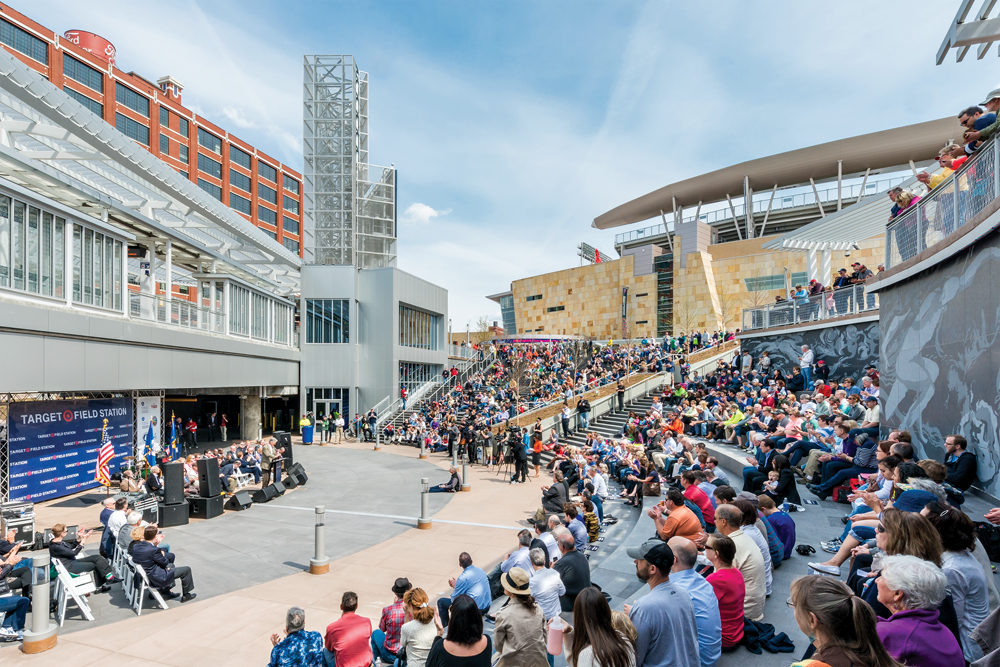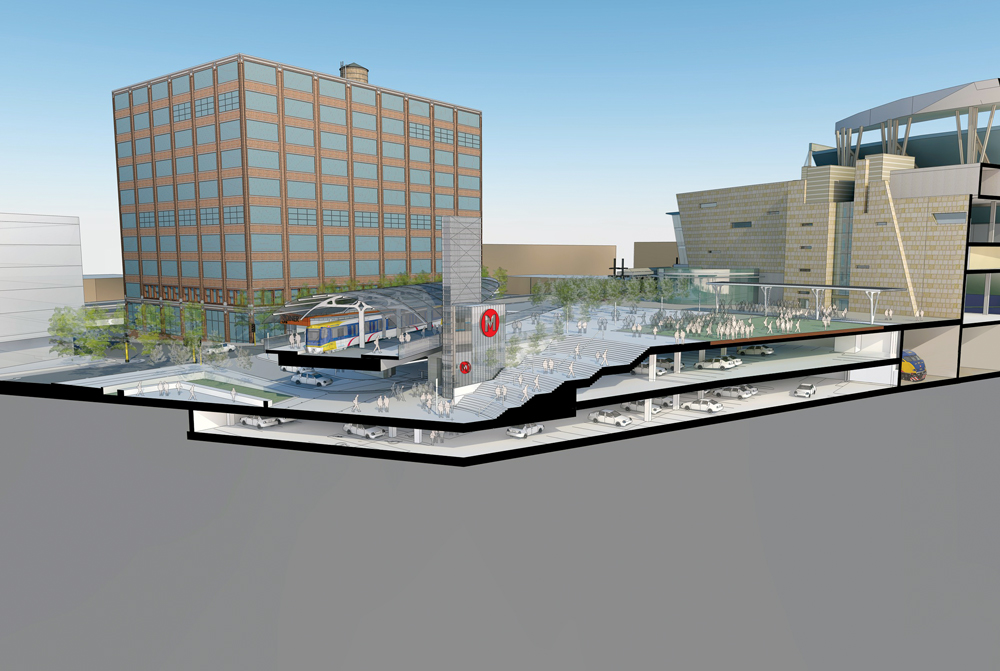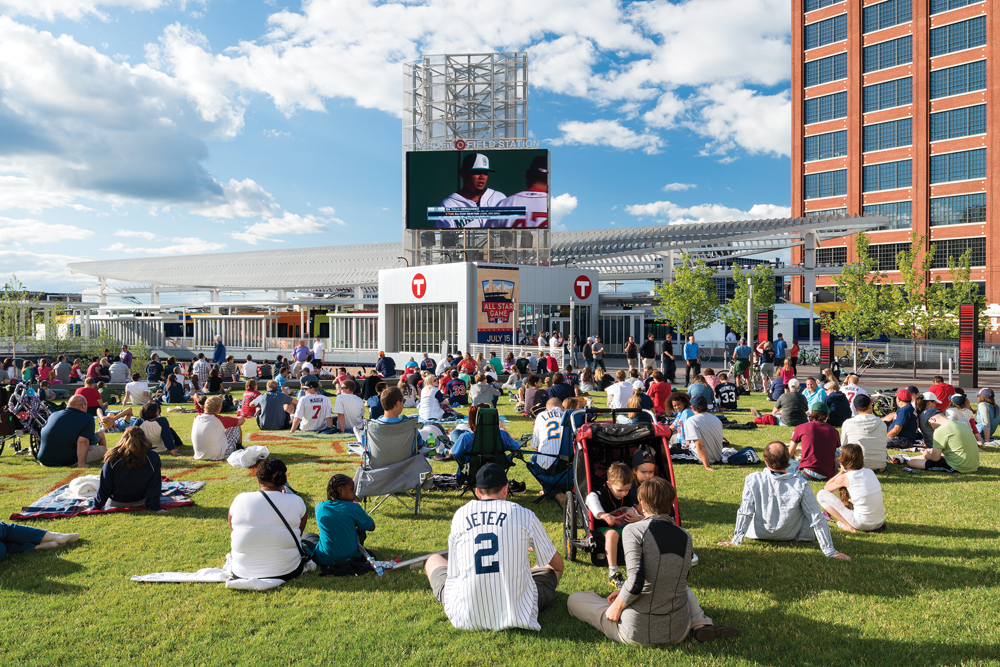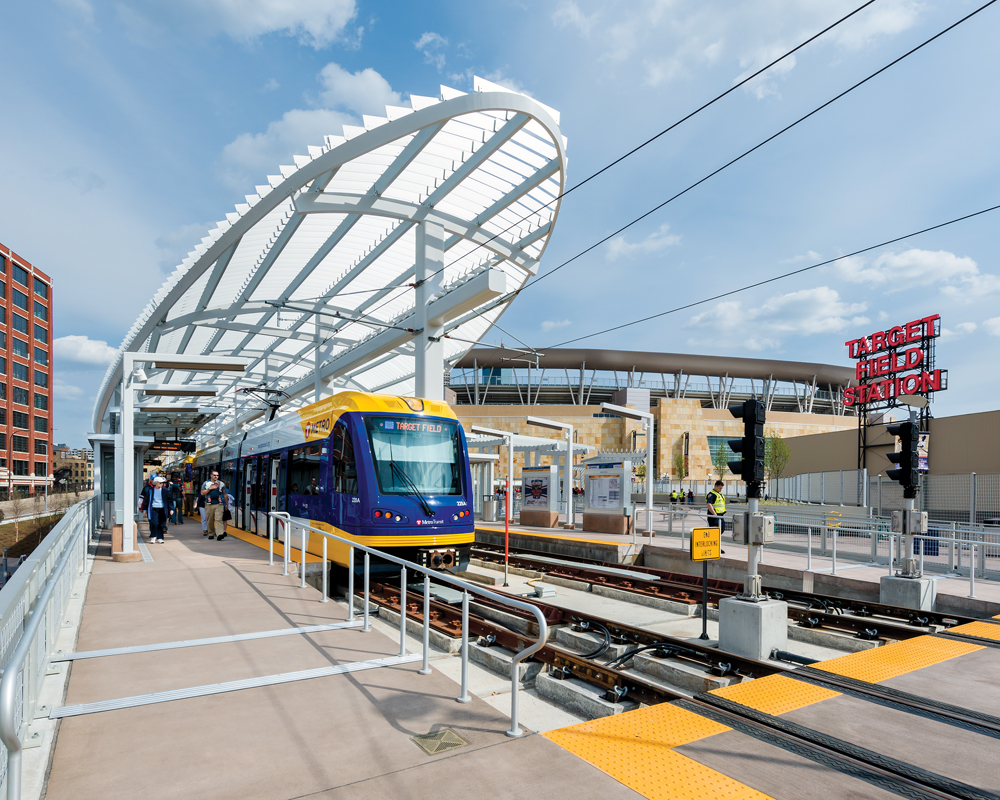Start with the train. Add something called “urban experience.” Turn it into a performance.
That was the thinking behind Target Field Station, which opened last May 17 in Minneapolis. The new light rail station connects the western terminus of the Metro Transit Green Line at Target Field, home of Major League Baseball’s Minnesota Twins, to its bookend 11 miles east at Union Station in St. Paul.
The 7,022-sf station, part of a 140,000-sf complex in the city’s ultra-hot North Loop, is the product of an intense design competition held in late 2011.
A design-build team led by New York–based architecture firm Perkins Eastman and local GC firm Knutson Construction beat four competitors to win the $82.5 million contract.
The design firm’s “Open Transit” concept was the key to the project. “It’s a design philosophy that comes from one principle: to create transit facilities that are so attractive people want to be there regardless of whether or not they’re taking a train,” says Peter Cavaluzzi, FAIA, Principal, Perkins Eastman. “Think about it as a live performance, and the trains are part of the performance.”
Cavaluzzi, who came to Perkins Eastman in a merger with EE&K in 2011, singles out New York’s Grand Central Terminal as the embodiment of Open Transit. “You have 750,000 people a day using Grand Central, but less than half actually board a train or subway car,” he says. Most come to shop, dine, people-watch, or simply to breathe in the magnificence of the space.

The amphitheater has become a popular space for civic events, concerts, and informal gatherings. It is a key element of the “Open Transit” philosophy, a design approach that seeks to make transit facilities so attractive people want to be there even if they’re not taking the train. Photo: © Morgan Sheff
As we’ll see, Target Field Station has, in its brief lifespan, already established itself as a lively performance space, attracting crowds for music, films, and sporting events. It is igniting real estate development in the North Loop at a sizzling rate. It has become the node of integration for multiple modes of transport—busses, trains, bicycles and, yes, even cars. And, in less than a year, it has turned into something of a—dare we say it? —iconic destination in the Twin Cities.
But first, let’s take a step back a bit into the station’s history.
KEEPING UP WITH DEMAND FOR TRANSIT
Before there was a Green Line, there was the Hiawatha, a 12-mile light rail line from downtown Minneapolis to the airport and the Mall of America, in Bloomington. The Hiawatha made its first headway on June 26, 2004. In November 2009, a new station, the Interchange, was opened to serve the North Loop neighborhood and Target Field, the nearly completed new home of the Twins.
Preliminary engineering for a second transit line was started in late 2006. Called the Central Corridor, it was planned to run along University Avenue from downtown St. Paul and the University of Minnesota to Minneapolis, terminating at the Interchange.
It took another four years for the Metropolitan Council, the regional planning agency in charge of the project, to come up with the initial $909 million funding and obtain environmental impact approvals from the federal government. Final design for the new rail line was completed in May 2010, shortly after Target Field opened.
Even before construction got under way, in late 2010, local officials worried that they had what Hennepin County Commissioner Peter McLaughlin would later call “a transit capacity problem.” Ridership on the Hiawatha, which had been strong from the start, went off the charts, especially on game days. “More people were taking the train to Target Field than we had expected,” he says.
Transit planners were concerned that, with the anticipated additional ridership from the Central Corridor line, and with two more extensions planned to the northwest and southwest, it might take two hours to clear the Interchange platform on a busy game day. Commuters were also attempting to cross live tracks to get from the Northstar suburban line to the transit platform.

The Cascade provides a three-dimensional experience for commuters and visitors to the station, some of whom have been known to run up the stairs and thrust their arms in the air à la Rocky. Rendering courtesy Perkins Eastman
“We needed to deal with the safety problems, and we needed better service,” said McLaughlin, Chair of the five-county regional Counties Transit Improvement Board. It was clear that the Interchange hub would have to be completely revamped, and it would have to be elevated.
Before that could happen, McLaughlin and other transit advocates had to sell the idea to the North Loop community, which Forbes would later name one of America’s top 20 hipster neighborhoods. “There were a lot of New Urbanist sensibilities there, and they opposed having an elevated station,” says McLaughlin. “They wanted it at street level.”
In late 2011, at a two-day charrette with stakeholders, the transit planners came up with a scheme to pull the station closer to the adjacent Hennepin Energy Recovery Center (“The HERC”), the county’s waste-to-energy facility. This would clear enough room to elevate the tracks, open up space for a storage track, and pave the way for much-needed street improvements in the surrounding neighborhood.
Getting the job done in the worst winter in 30 years
The last six months of construction on Target Field Station took place during the worst winter in 30 years in Minnesota, and that’s saying something. Crews from Knutson Construction had to bear up against 23 days of -25?F weather. They worked six days a week and some Sundays to get the station ready for its May 17, 2014, opening.
Pouring colored concrete for the plaza and walkways took some doing. “Colored concrete is so finicky,” says Rob Bremer, Knutson’s Project Manager on the job. To to maintain the consistency in the frigid cold, crews erected 20x20-foot stick-frame shelters, covered them with plastic, and poured the concrete in 10x10-foot squares. It was not fun. “Working in a 20x20 enclosure, your productivity goes way down,” he says.
Knutson crews had to take a similar tack in order to paint and caulk the massive canopy that covers the station platform. They erected scaffolding over the entire structure and covered it in reinforced polyethylene tarp. Three-fourths of the forms for the 286-car parking ramp had to be cut and set by hand to account for numerous dimensional changes.
The city wanted nothing to do with hauling snow from the station, so more than 50 miles of snow-melt tubing was installed. “Salt would only discolor the concrete,” says Bremer.
The logistical problems seemed endless. The plan called for reconfiguring the entrance to the waste-to-energy facility, but HERC staff were deaf to any talk of interrupting the flow of their trucks—365 a day. Knutson put in a temporary road for the haulers, and then created a wider entrance with a snow-melt system. The contractor also had to rebuild nearly 250 feet of a four-lane road right next to the municipal bus hub.
Work had to be halted to accommodate 10-12 BNSF freight trains every day. “We had to have a BNSF flagger out there, and when the train was a mile away, everything had to stop, and then we’d have to wait till it was a mile past us,” says Bremer.
Structural engineering for the project was equally problematic, says Swami Palanisami, PE, Owner and Principal, Palanisami & Associates. No task was more difficult than getting the loads right for the Cascade. Palanisami used a technique he calls staged post-tensioning: “We’d put some load on and tension the cable, then more load and tension the cable, and so on,” he recalls. “Every beam, every column was like a piece of artwork.”
Palanisami says Target Field Station posed “some of the most complex geometries I’ve ever worked on in my 44 years as an engineer.”
“The charrette turned the tide,” says McLaughlin. The North Loop neighborhood bought into elevating the Interchange. In 2011, Hennepin County issued an RFP to design-build teams to bid on the project.
All the bids came in over budget, and the county had to recalibrate its numbers. In December 2011, the five finalists were given until March, less than three months away, to resubmit their bids.
COMING IN STRONG FROM WAY BACK IN THE PACK
“We were a dark horse,” says Cavaluzzi, referring to the Perkins Eastman/Knutson Construction design-build team. “We came in late, but the good thing is, it became a contest for the best design, not just the lowest bidder.”
In July 2012, their $85.2 million bid was selected. As Hennepin County’s McLaughlin put it, “The RFP process was difficult, but we got a great product.”
Last May 17, less than two years from the start of construction, the newly named Target Field Station officially opened. (Target Corporation paid $1.75 million for the naming rights.) On June 14, 2014, the newly christened Green Line started service at 18 new stations and five it shares with the Blue Line, the new name for the Hiawatha Line.
Two features put the Perkins Eastman/Knutson bid over the top in the bidding: the Great Lawn and the Cascade. These Open Transit elements transfigured what could have been a run-of-the-mill train stop into an instant urban village.
The 7,100-sf Great Lawn, designed in cooperation with landscape architect Olin/SEH, quickly turned into a popular gathering spot for pregame events, concerts, and casual outdoor activities. A 16x29-foot video board (donated by Target Corporation) sits atop the elevator core, making it visible from the Great Lawn and upper plaza. Last summer, it became the place to watch World Cup soccer and Twins games, and there were movie nights and music events.
A 1,000-seat amphitheater and a sloping, informal seating area form the second Open Transit feature, the Cascade. To Cavaluzzi, the amphitheater’s thrust stage recalls Ralph Rapson’s Guthrie Theater. (Cavaluzzi received his MArch from the University of Minnesota and was a Minnesota Architectural Foundation Ralph Rapson Fellow.) Live concerts sponsored by a local radio station have attracted enthusiastic crowds.
Cavaluzzi says the Cascade pays homage to Olmsted and Vaux’s Bethesda Terrace in New York’s Central Park—with a touch of Philadelphia thrown in: “People feel compelled to dash up to the top and pump their fists like Rocky,” he says.
All the while the trains glide in overhead—“almost whisper-quiet,” says Cavaluzzi. “Think of it as a live performance venue, and the trains are part of the performance.”
In addition to the Great Lawn and the Cascade, Target Field Station benefits from many hidden touches, chief of which is a snow-melt system that uses waste heat from “The HERC” to pump warm water through 50 miles of pipe. This keeps the plaza clear of snow and makes it much more attractive, even in the worst days of the Minnesota winter. Colored concrete was scored, sandblasted, and otherwise treated with a variety of finishes for optimal aesthetic effect.
The green roof and a system of tree pits collect stormwater, which is filtered and stored in giant cisterns that can hold 40,000 gallons. Lighting designer Schuler Shook created a light garden with nine programmable wall fixtures and light sticks; the canopy above the LRT station platform is lit with programmable LEDs.

The Great Lawn has become the place where even a Yankee fan can enjoy the live broadcast of a Minnesota Twins’ game. Last June and July it was the hot spot to catch World Cup soccer on the 16x29-foot video board. Landscaping and architectural features like this have made Target Field Station an entertainment venue and community gathering space, not just a transportation hub. Photo: © Morgan Sheff
The project is certified under LEED and Minnesota’s “Buildings, Benchmarks and Beyond” guidelines. Cavaluzzi says that standard measures of sustainability are difficult to apply to a transit station. He argues that, by enabling year-round use, the station is, by its very nature, highly sustainable.
According to the Minneapolis Star-Tribune, about a third of the financing came from the federal government, 30% from the county, 20% from the state, and the rest from the city and the Minnesota Ballpark Authority. The Twins and United Properties, a division of the Pohlan Family Companies (the owners of the ballpark), chipped in $3.6 million.
TALLYING UP THE PAYOFF
Development activity in the North Loop is proceeding at what the Star-Tribune has called “a blistering pace.” Office buildings, retail stores, and apartment buildings are replacing desolate parking lots in the old red-brick industrial district.
In November, Trammell Crow had no trouble flipping its 182-unit Junction Flats apartment complex, which it completed just a few months before, for $49 million.
Hines has several projects going in the North Loop, the latest a 210,000-sf, seven-story wooden speculative office building it’s calling T3 (for “timber, transit, technology”).
United Properties is beavering away on a $60 million headquarters that will house 800 employees of Be the Match, the nonprofit bone marrow registry. United also completed the renovation of the 10-story Ford Center, a 270,131-sf historic Model T factory across from the station, and the 112,645-sf Loose-Wiles Biscuit Company Building; both are about 99% leased.
In November, United Properties announced plans for Target Field Station Center, a 10-story, 240,000-sf office building that it will develop on spec—another sign of the transit node’s vitality. United is in the process of buying a three-quarter-acre parcel for the project from Hennepin County for $1.5 million; the county will get $15/sf (minus the $1.5 million) from future leases. “That could net out to $2 million,” says Commissioner McLaughlin.
McLaughlin recently reflected on the county’s original vision for the project. “We wanted a transit station that worked well, but we also wanted a public space that would be noteworthy, a statement—not just for 81 home baseball games, but a great civic space that would function 365 days a year.”
By all accounts, Target Field Station is well on its way to realizing that vision.
Related Stories
Giants 400 | Oct 30, 2023
Top 170 K-12 School Architecture Firms for 2023
PBK Architects, Huckabee, DLR Group, VLK Architects, and Stantec top BD+C's ranking of the nation's largest K-12 school building architecture and architecture/engineering (AE) firms for 2023, as reported in Building Design+Construction's 2023 Giants 400 Report.
Giants 400 | Oct 30, 2023
Top 100 K-12 School Construction Firms for 2023
CORE Construction, Gilbane, Balfour Beatty, Skanska USA, and Adolfson & Peterson top BD+C's ranking of the nation's largest K-12 school building contractors and construction management (CM) firms for 2023, as reported in Building Design+Construction's 2023 Giants 400 Report.
Giants 400 | Oct 30, 2023
Top 80 K-12 School Engineering Firms for 2023
AECOM, CMTA, Jacobs, WSP, and IMEG head BD+C's ranking of the nation's largest K-12 school building engineering and engineering/architecture (EA) firms for 2023, as reported in Building Design+Construction's 2023 Giants 400 Report.
MFPRO+ Special Reports | Oct 27, 2023
Download the 2023 Multifamily Annual Report
Welcome to Building Design+Construction and Multifamily Pro+’s first Multifamily Annual Report. This 76-page special report is our first-ever “state of the state” update on the $110 billion multifamily housing construction sector.
Giants 400 | Oct 23, 2023
Top 190 Multifamily Architecture Firms for 2023
Humphreys and Partners, Gensler, Solomon Cordwell Buenz, Niles Bolton Associates, and AO top the ranking of the nation's largest multifamily housing sector architecture and architecture/engineering (AE) firms for 2023, as reported in Building Design+Construction's 2023 Giants 400 Report. Note: This ranking factors revenue for all multifamily buildings work, including apartments, condominiums, student housing facilities, and senior living facilities.
Affordable Housing | Oct 20, 2023
Cracking the code of affordable housing
Perkins Eastman's affordable housing projects show how designers can help to advance the conversation of affordable housing.
Senior Living Design | Oct 19, 2023
Senior living construction poised for steady recovery
Senior housing demand, as measured by the change in occupied units, continued to outpace new supply in the third quarter, according to NIC MAP Vision. It was the ninth consecutive quarter of growth with a net absorption gain. On the supply side, construction starts continued to be limited compared with pre-pandemic levels.
Warehouses | Oct 19, 2023
JLL report outlines 'tremendous potential' for multi-story warehouses
A new category of buildings, multi-story warehouses, is beginning to take hold in the U.S. and their potential is strong. A handful of such facilities, also called “urban logistics buildings” have been built over the past five years, notes a new report by JLL.
Building Materials | Oct 19, 2023
New white papers offer best choices in drywall, flooring, and insulation for embodied carbon and health impacts
“Embodied Carbon and Material Health in Insulation” and “Embodied Carbon and Material Health in Gypsum Drywall and Flooring,” by architecture and design firm Perkins&Will in partnership with the Healthy Building Network, advise on how to select the best low-carbon products with the least impact on human health.
Contractors | Oct 19, 2023
Crane Index indicates slowing private-sector construction
Private-sector construction in major North American cities is slowing, according to the latest RLB Crane Index. The number of tower cranes in use declined 10% since the first quarter of 2023. The index, compiled by consulting firm Rider Levett Bucknall (RLB), found that only two of 14 cities—Boston and Toronto—saw increased crane counts.

















